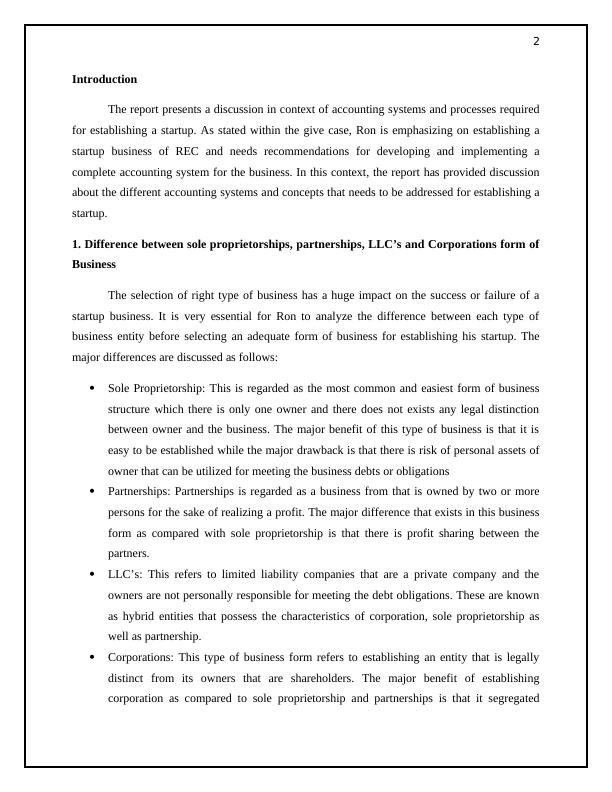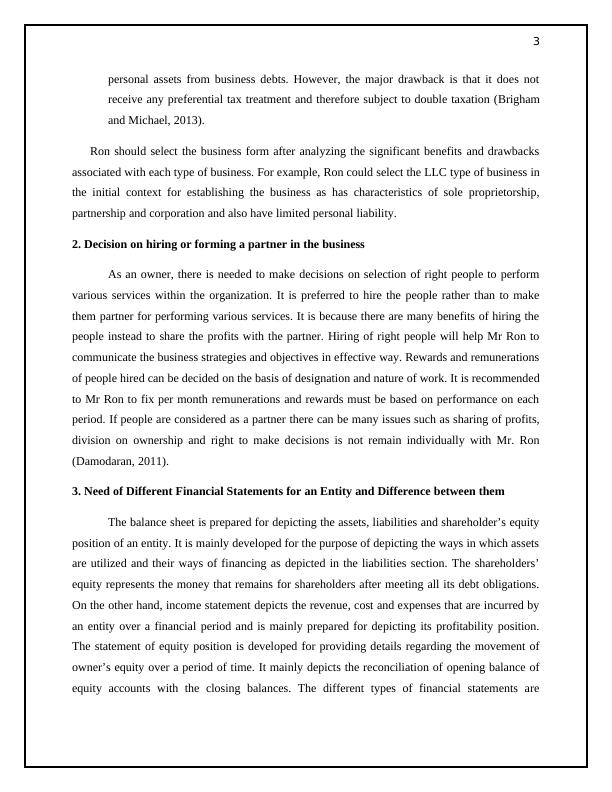Assignment On Developing And Implementing A Complete Accounting System
6 Pages1408 Words17 Views
Added on 2022-10-04
Assignment On Developing And Implementing A Complete Accounting System
Added on 2022-10-04
ShareRelated Documents
1
Financial accounting
Financial accounting

2
Introduction
The report presents a discussion in context of accounting systems and processes required
for establishing a startup. As stated within the give case, Ron is emphasizing on establishing a
startup business of REC and needs recommendations for developing and implementing a
complete accounting system for the business. In this context, the report has provided discussion
about the different accounting systems and concepts that needs to be addressed for establishing a
startup.
1. Difference between sole proprietorships, partnerships, LLC’s and Corporations form of
Business
The selection of right type of business has a huge impact on the success or failure of a
startup business. It is very essential for Ron to analyze the difference between each type of
business entity before selecting an adequate form of business for establishing his startup. The
major differences are discussed as follows:
Sole Proprietorship: This is regarded as the most common and easiest form of business
structure which there is only one owner and there does not exists any legal distinction
between owner and the business. The major benefit of this type of business is that it is
easy to be established while the major drawback is that there is risk of personal assets of
owner that can be utilized for meeting the business debts or obligations
Partnerships: Partnerships is regarded as a business from that is owned by two or more
persons for the sake of realizing a profit. The major difference that exists in this business
form as compared with sole proprietorship is that there is profit sharing between the
partners.
LLC’s: This refers to limited liability companies that are a private company and the
owners are not personally responsible for meeting the debt obligations. These are known
as hybrid entities that possess the characteristics of corporation, sole proprietorship as
well as partnership.
Corporations: This type of business form refers to establishing an entity that is legally
distinct from its owners that are shareholders. The major benefit of establishing
corporation as compared to sole proprietorship and partnerships is that it segregated
Introduction
The report presents a discussion in context of accounting systems and processes required
for establishing a startup. As stated within the give case, Ron is emphasizing on establishing a
startup business of REC and needs recommendations for developing and implementing a
complete accounting system for the business. In this context, the report has provided discussion
about the different accounting systems and concepts that needs to be addressed for establishing a
startup.
1. Difference between sole proprietorships, partnerships, LLC’s and Corporations form of
Business
The selection of right type of business has a huge impact on the success or failure of a
startup business. It is very essential for Ron to analyze the difference between each type of
business entity before selecting an adequate form of business for establishing his startup. The
major differences are discussed as follows:
Sole Proprietorship: This is regarded as the most common and easiest form of business
structure which there is only one owner and there does not exists any legal distinction
between owner and the business. The major benefit of this type of business is that it is
easy to be established while the major drawback is that there is risk of personal assets of
owner that can be utilized for meeting the business debts or obligations
Partnerships: Partnerships is regarded as a business from that is owned by two or more
persons for the sake of realizing a profit. The major difference that exists in this business
form as compared with sole proprietorship is that there is profit sharing between the
partners.
LLC’s: This refers to limited liability companies that are a private company and the
owners are not personally responsible for meeting the debt obligations. These are known
as hybrid entities that possess the characteristics of corporation, sole proprietorship as
well as partnership.
Corporations: This type of business form refers to establishing an entity that is legally
distinct from its owners that are shareholders. The major benefit of establishing
corporation as compared to sole proprietorship and partnerships is that it segregated

3
personal assets from business debts. However, the major drawback is that it does not
receive any preferential tax treatment and therefore subject to double taxation (Brigham
and Michael, 2013).
Ron should select the business form after analyzing the significant benefits and drawbacks
associated with each type of business. For example, Ron could select the LLC type of business in
the initial context for establishing the business as has characteristics of sole proprietorship,
partnership and corporation and also have limited personal liability.
2. Decision on hiring or forming a partner in the business
As an owner, there is needed to make decisions on selection of right people to perform
various services within the organization. It is preferred to hire the people rather than to make
them partner for performing various services. It is because there are many benefits of hiring the
people instead to share the profits with the partner. Hiring of right people will help Mr Ron to
communicate the business strategies and objectives in effective way. Rewards and remunerations
of people hired can be decided on the basis of designation and nature of work. It is recommended
to Mr Ron to fix per month remunerations and rewards must be based on performance on each
period. If people are considered as a partner there can be many issues such as sharing of profits,
division on ownership and right to make decisions is not remain individually with Mr. Ron
(Damodaran, 2011).
3. Need of Different Financial Statements for an Entity and Difference between them
The balance sheet is prepared for depicting the assets, liabilities and shareholder’s equity
position of an entity. It is mainly developed for the purpose of depicting the ways in which assets
are utilized and their ways of financing as depicted in the liabilities section. The shareholders’
equity represents the money that remains for shareholders after meeting all its debt obligations.
On the other hand, income statement depicts the revenue, cost and expenses that are incurred by
an entity over a financial period and is mainly prepared for depicting its profitability position.
The statement of equity position is developed for providing details regarding the movement of
owner’s equity over a period of time. It mainly depicts the reconciliation of opening balance of
equity accounts with the closing balances. The different types of financial statements are
personal assets from business debts. However, the major drawback is that it does not
receive any preferential tax treatment and therefore subject to double taxation (Brigham
and Michael, 2013).
Ron should select the business form after analyzing the significant benefits and drawbacks
associated with each type of business. For example, Ron could select the LLC type of business in
the initial context for establishing the business as has characteristics of sole proprietorship,
partnership and corporation and also have limited personal liability.
2. Decision on hiring or forming a partner in the business
As an owner, there is needed to make decisions on selection of right people to perform
various services within the organization. It is preferred to hire the people rather than to make
them partner for performing various services. It is because there are many benefits of hiring the
people instead to share the profits with the partner. Hiring of right people will help Mr Ron to
communicate the business strategies and objectives in effective way. Rewards and remunerations
of people hired can be decided on the basis of designation and nature of work. It is recommended
to Mr Ron to fix per month remunerations and rewards must be based on performance on each
period. If people are considered as a partner there can be many issues such as sharing of profits,
division on ownership and right to make decisions is not remain individually with Mr. Ron
(Damodaran, 2011).
3. Need of Different Financial Statements for an Entity and Difference between them
The balance sheet is prepared for depicting the assets, liabilities and shareholder’s equity
position of an entity. It is mainly developed for the purpose of depicting the ways in which assets
are utilized and their ways of financing as depicted in the liabilities section. The shareholders’
equity represents the money that remains for shareholders after meeting all its debt obligations.
On the other hand, income statement depicts the revenue, cost and expenses that are incurred by
an entity over a financial period and is mainly prepared for depicting its profitability position.
The statement of equity position is developed for providing details regarding the movement of
owner’s equity over a period of time. It mainly depicts the reconciliation of opening balance of
equity accounts with the closing balances. The different types of financial statements are

End of preview
Want to access all the pages? Upload your documents or become a member.
Related Documents
Partners of a limited liability companylg...
|3
|843
|22
Business Types and Functions: Understanding Business Organisationlg...
|7
|2150
|315
Limited Liability Company: Merits and Demerits, Financial Analysis of Next Plclg...
|11
|2110
|363
Interpretation of Financial Statements of Next Plc through Ratio Analysislg...
|15
|3085
|470
Finance Assignment - Solvedlg...
|6
|1282
|47
Financial Accounting and Reporting Assignment - Next Plclg...
|12
|2352
|300
